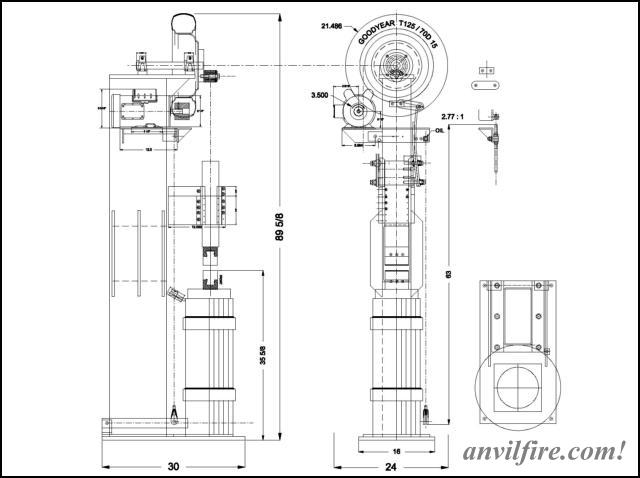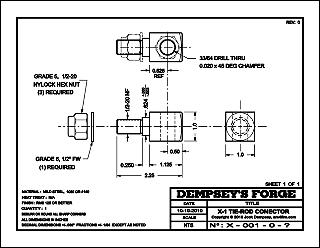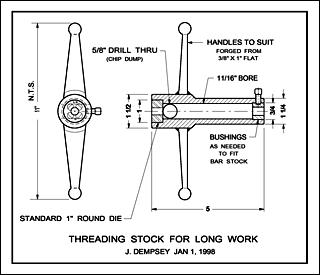Detail plans are in progress. Not currently available.
As noted in other parts of this article we have found things that needed to be changed for various reasons.
If we do not take advantage of learning from our mistakes then we have wasted our efforts.
One of the biggest mistakes we made was not having a true scale drawing of the hammer when we started.
The assembly drawing below was made when the hammers were nearly completed to determine changes that needed to be made.
The biggest change was making the frame higher.
One of my design constraints was to make the hammer as short as possible and this was a mistake in itself.
The mechanism should determine the space needed then be optimized or scaled down.
As it is we raised the hammer 3" and it should have been more.
While we raised this design new plans will result in a much shorter mechanism and overall shorter machine.

X1 ASSEMBLY DRAWING (Incomplete)

SAMPLE DRAWINGS
Click images at left for Adobe Acrobat sample CAD detail drawings.
These are typical detail drawings made to clear, easy to understand standards with copious notes.
Drawings such as these are suitable to have any machinist make the parts from.
These drawings are X1 as-builts and do not apply to X2 plans other than the pulley.
The threading tool is here for reference purposes.

While the rocker parts look complicated to make they were made with a drill press and cut-off saw plus a little time with a die grinder.
See the photos on Page 1
Multiple pieces are made from short sections of stock and are more efficient than they look.
 Our original pulleys had 5/8" bores to fit the 1.5HP motors we had bought.
After looking at the heavy pulley on that little shaft I decided to get motors with a bigger shaft (7/8").
In the past all the Baldor TEFC 1.5 HP motors I had purchased had 7/8 (.875) inch shafts.
I had not even thought of the difference in frame sizes when I purchased these motors.
Our original pulleys had 5/8" bores to fit the 1.5HP motors we had bought.
After looking at the heavy pulley on that little shaft I decided to get motors with a bigger shaft (7/8").
In the past all the Baldor TEFC 1.5 HP motors I had purchased had 7/8 (.875) inch shafts.
I had not even thought of the difference in frame sizes when I purchased these motors.
As drawn this is a relatively heavy pulley that should have more material removed to lighten it.
New drawings will probably show a 50% lighter pulley.
 My Long Threading Stock was made for a job back in the 1970's for making U-bolts and has come in handy a number of times.
I wrote an article about it in 1989 for
The Blacksmith's Gazette.
My Long Threading Stock was made for a job back in the 1970's for making U-bolts and has come in handy a number of times.
I wrote an article about it in 1989 for
The Blacksmith's Gazette.
The advantage of this tool is it has a long body and a guide bushing at the far end.
To thread a piece of rod you just cram it on and start cranking.
It will easily make a long straight thread unlike conventional die stocks.
On the drill press I reversed the start end of the die and used it udside down.
A short piece of round bar stock was used as a guide.
We used it to make our treadle connecting parts.
CAD (Computer Aided Design)
CAD Has advantages and disadvantages.
Its disadvantages are that it is much slower than manual drafting, file formats are not universal and they become obsolete.
The result is that an inventory of CAD files can all become useless if they are not constantly updated and converted to the newest file format.
While paper or film drawing files have issues they do not become obsolete overnight and as long as they are physically protected can last centuries.
The advantages of CAD are, every print is an original in quality,
changes (erasures) are seamless, many versions of a drawing can be kept as a record of changes,
CAD drawings can be used to control machines without complex programming for each part,
and CAD drawings can be transmitted across the world electronically.
Today the most universal file format for complex documents is the Adobe Acrobat PDF file.
Output from any program that can be captured by Adobe Acrobat can be read and printed out by virtually every computer system world wide.
This makes drawings from a decades old CAD program just as useful as from the latest versions.
They can also be scaled up and down, and output to various types of printers and plotters.
Dozens or hundreds of detail drawings can be stored and accessed from a portable graphic device.
While the PDF format does not hold still so many systems rely on it that all new readers will probably read the oldest formats which is not true of most other file foramts.
Our plans when they become available will all be in Adobe Acrobat PDF format as the samples above,
OR JPG's (common graphic files), and text in HTML format all readable by any web browser or portable graphics device with standard capabilities.




One of the biggest mistakes we made was not having a true scale drawing of the hammer when we started. The assembly drawing below was made when the hammers were nearly completed to determine changes that needed to be made. The biggest change was making the frame higher. One of my design constraints was to make the hammer as short as possible and this was a mistake in itself. The mechanism should determine the space needed then be optimized or scaled down. As it is we raised the hammer 3" and it should have been more.
While we raised this design new plans will result in a much shorter mechanism and overall shorter machine.
Click images at left for Adobe Acrobat sample CAD detail drawings.
These are typical detail drawings made to clear, easy to understand standards with copious notes. Drawings such as these are suitable to have any machinist make the parts from.
These drawings are X1 as-builts and do not apply to X2 plans other than the pulley. The threading tool is here for reference purposes.

While the rocker parts look complicated to make they were made with a drill press and cut-off saw plus a little time with a die grinder. See the photos on Page 1 Multiple pieces are made from short sections of stock and are more efficient than they look.
As drawn this is a relatively heavy pulley that should have more material removed to lighten it. New drawings will probably show a 50% lighter pulley.
The advantage of this tool is it has a long body and a guide bushing at the far end. To thread a piece of rod you just cram it on and start cranking. It will easily make a long straight thread unlike conventional die stocks.
On the drill press I reversed the start end of the die and used it udside down. A short piece of round bar stock was used as a guide.
We used it to make our treadle connecting parts.
CAD (Computer Aided Design)
CAD Has advantages and disadvantages. Its disadvantages are that it is much slower than manual drafting, file formats are not universal and they become obsolete. The result is that an inventory of CAD files can all become useless if they are not constantly updated and converted to the newest file format. While paper or film drawing files have issues they do not become obsolete overnight and as long as they are physically protected can last centuries.The advantages of CAD are, every print is an original in quality, changes (erasures) are seamless, many versions of a drawing can be kept as a record of changes, CAD drawings can be used to control machines without complex programming for each part, and CAD drawings can be transmitted across the world electronically.
Today the most universal file format for complex documents is the Adobe Acrobat PDF file. Output from any program that can be captured by Adobe Acrobat can be read and printed out by virtually every computer system world wide. This makes drawings from a decades old CAD program just as useful as from the latest versions. They can also be scaled up and down, and output to various types of printers and plotters. Dozens or hundreds of detail drawings can be stored and accessed from a portable graphic device. While the PDF format does not hold still so many systems rely on it that all new readers will probably read the oldest formats which is not true of most other file foramts.
Our plans when they become available will all be in Adobe Acrobat PDF format as the samples above, OR JPG's (common graphic files), and text in HTML format all readable by any web browser or portable graphics device with standard capabilities.